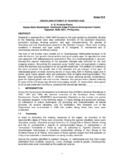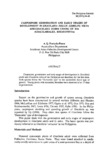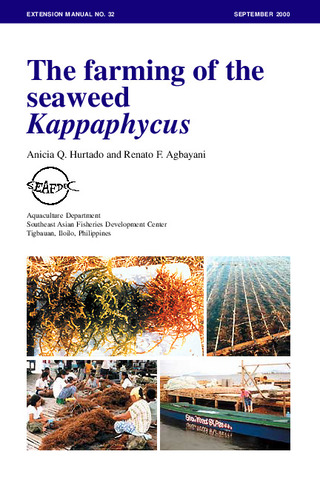Gracilaria studies at SEAFDEC/AQD
Share
抄録
Research in seaweed from 1988–1994 focused on the agar producing Gracilaria. Studies in the following areas were also conducted: inventory of the seaweed resources; production ecology; farming systems; and agar characterisation. Six species of Gracilaria and one Gracilariopsis abound in the Western Visayas. There were monthly variations in biomass and agar quality of G. blodgettii, G. manilaensis and G. heteroclada collected at different places.
The bulk of the studies were carried out on Gracilariopsis heteroclada because of its wide distribution, fast growth characteristics and good quality agar. Its reproductive state was seasonal with tetrasporophyte abundant in May and carposporophyte in January. Seventy-five percent harvesting of the available biomass was sufficient for the next cropping season. Harvesting the seaweed using “araña” was not appropriate in places where the biomass was exposed to air during the lowest tide. The addition of nutrients to the stock increased the growth rate of the seaweed and gel strength of the agar. G. heteroclada grown at lower stocking density in hapa nets, both in floating cages and in ponds, gave higher growth rates and production than at higher stocking densities. This species, when polycultured with P. monodon at lower stocking density combinations, gave the highest growth rate and income. Likewise, this species when cultured vertically in ropes inside a floating cage showed encouraging results. G. heteroclada, when grown at 24–25 ppt under tank conditions, produced the highest gel strength.
Suggested Citation
Hurtado-Ponce, A. Q. (1996). Gracilaria studies at SEAFDEC/AQD. In Report on a Regional Study and Workshop on the Taxonomy, Ecology and Processing of Economically Important Red Seaweeds (pp. 311-317). Bangkok, Thailand: Network of Aquaculture Centres in Asia-Pacific.
主題
Taxonomic term
Collections
Related items
Showing items related by title, author, creator and subject.
-
Research on seaweeds and mollusks
Hurtado-Ponce, Anicia Q. (Aquaculture Department, Southeast Asian Fisheries Development Center, 1995)Research on seaweeds focused on the carrageenan-producing Kappaphycus alvarezii and the agar-producing Gracilaria spp. Growth of K. alvarezii was better on horizontal lines than on vertical or cluster lines from bamboo ... -
Carpospore germination and early stages of development in Gracilaria edulis (Gmelin) Silva and Gracilaria rubra Chang et Xia (Gracilariales, Rhodophyta)
Hurtado-Ponce, Anicia Q. (San Carlos Publications, University of San Carlos, 1993)Carpospore germination and early stages of development in Gracilaria edulis and Gracilaria rubra of the Philippines are described for the first time. Both species follow the "Dumontia type" or the immediate discal type of ... -
The farming of the seaweed Kappaphycus
Hurtado, Anicia Q.; Agbayani, Renato F. (Aquaculture Department, Southeast Asian Fisheries Development Center, 2000)A 24-page manual that introduces the carrageenan-producing seaweed Kappaphycus whose culture has spread from Jolo in Mindanao to at least 14 sites in the Visayas and Luzon. Four culture methods are presented: fixed off-bottom, ...






